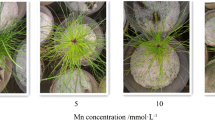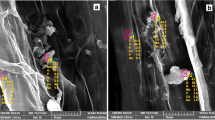Abstract
Polygonum perfoliatum L. is a Mn-tolerant plant as considered having the potential to revegetate in manganese mine wasteland. The glasshouse experiments were carried out to evaluate its tolerance and physiological response in different Mn concentrations (5, 500, 1000, 2000, 5000, and 10,000 μmol L−1). Absorption bands of P. perfoliatum differed greatly in lipids, proteins, and carbohydrates. With elevated levels of Mn (5–2000 μmol L−1), absorbance changed little, which demonstrated that lower Mn concentrations had negligible influence on transport functions. As Mn concentrations in excess of 2000 μmol L−1, absorbance increased slightly but eventually decreased. Furthermore, a hydroponic culture was carried out in order to study its changes of ultrastructure with the increasing Mn concentrations (5, 1000, and 10,000 μmol L−1). Lower Mn levels with 5 and 1000 μmol L−1 had no breakage function to the ultrastructure of P. perfoliatum. However, as Mn concentration was up to 10,000 μmol L−1, visible damages began to appear, the quantity of mitochondria in root cells increased, and the granum lamellae of leaf cell chloroplasts presented a disordered state. In comparison with the controls, black agglomerations were found in the cells of P. perfoliatum under the controlling concentration of Mn with 1000 and 10,000 μmol L−1 for 30 days, which became obvious at higher Mn concentrations. As Mn concentration was 10,000 μmol L−1, a kind of new acicular substance was developed in leaf cells and intercellular spaces, possibly indicating a resistance mechanism in P. perfoliatum. These results confirm that P. perfoliatum shows potential for the revegetation of abandoned manganese tailings.








Similar content being viewed by others
References
Blamey P, Hernandez-Soriano M, Cheng M, Tang C, Paterson D, Lombi E, Wang WH, Scheckel K, Kopittke PM (2015) Synchrotron-based techniques shed light on mechanisms of plant sensitivity and tolerance to high manganese in the root environment. Plant Physiol 169(3):2006–2020
Chen Z, Wang YP, Jiang XL, Fu D, Xia D, Wang HT, Dong GW, Li QB (2017) Dual roles of AQDS as electron shuttles for microbes and dissolved organic matter involved in arsenic and iron mobilization in the arsenic-rich sediment. Sci Total Environ 574:1684–1694
Costa GB, Simioni C, Ramlov F, Maraschin M, Chow F, Bouzon ZL, Schmidt EC (2017) Effects of manganese on the physiology and ultrastructure of Sargassum cymosum. Environ Exp Bot 133:24–34
Das A, Mazumdar K (2016) Phytoremediation potential of a novel fern, Salvinia cucullata, Roxb. ex Bory, to pulp and paper mill effluent: physiological and anatomical response. Chemosphere 163:62–72
Deng H, Li MS, Chen YX, Luo YP, Yu FM (2010) A new discovered manganese hyperaccumulator—Polygonum pubescens Blume. Fresenius Environ Bull 19(1):94–99
Dou CM, Fu XP, Chen XC, Shi JY, Chen YX (2009) Accumulation and detoxification of manganese in hyperaccumulator Phytolacca americana. Plant Biol 11(5):664–670
Dučić T, Thieme J, Polle A (2012) Phosphorus compartmentalization on the cellular level of Douglas fir root as affected by Mn toxicity: a synchrotron-based FTIR approach. Spectroscopy 27(5–6):265–272
Esteban E, Deza MJ, Zornoza P (2013) Kinetics of mercury uptake by oilseed rape and white lupin: influence of Mn and Cu. Acta Physiol Plant 35(35):2339–2344
Fernando DR, Lynch JP (2015) Manganese phytotoxicity: new light on an old problem. Ann Bot 116(3):313–319
Fernando DR, Marshall AT, Forster PI, Hoebee SE, Siegele R (2013) Multiple metal accumulation within a manganese-specific genus. Am J Bot 100(4):690–700
Hauck M, Paul A, Gross S, Raubuch M (2003) Manganese toxicity in epiphytic lichens: chlorophyll degradation and interaction with iron and phosphorus. Environ Exp Bot 49(2):181–191
Keller C, Rizwan M, Davidian JC, Pokrovsky OS, Bovet N, Chaurand P, Meunier JD (2015) Effect of silicon on wheat seedlings (Triticum turgidum L.) grown in hydroponics and exposed to 0 to 30 μm Cu. Planta 241(4):847–860
Kim D, Gustin JL, Lahner B, Michael W, Baek D, Yun DJ (2004) The plant CDF family member TgMTP1 from the Ni/Zn hyperaccumulator Thlaspi goesingense acts to enhance efflux of Zn at the plasma membrane when expressed in Saccharomyces cerevisiae. Plant J 39(2):237–251
Kochian LV, Hoekenga OA, Pineros MA (2004) How do crop plants tolerate acid soils?—mechanisms of aluminum tolerance and phosphorous efficiency. Annu Rev Plant Biol 55(1):459–493
Kong XF, Li M, Xue SG, Hartley W, Chen CR, Wu C, Li XF, Li YW (2017) Acid transformation of bauxite residue: conversion of its alkaline characteristics. J Hazard Mater. doi:10.1016/j.jhazmat.2016.10.073
Kupper H, Jie ZF, Mcgrath SP (1999) Cellular compartmentation of zinc in leaves of the hyperaccumulator Thlaspi caerulescens. Plant Physiol 119(1):305–312
Li M, Cheng XH, Guo HX (2013) Heavy metal removal by biomineralization of urease producing bacteria isolated from soil. Int Biodeterior Biodegrad 76(1):81–85
Liang WB, Xue SG, Shen JH, Wang P, Wang J (2011) Manganese stress on morphological structures of leaf and ultrastructures of chloroplast of a manganese hyperaccumulator-Phytolacca americana L. Acta Ecol Sin 31(13):3677–3683
Liu YN, Guo ZH, Xiao XY, Wang S, Jiang ZC, Zeng P (2017) Phytostabilisation potential of giant reed for metals contaminated soil modified with complex organic fertiliser and fly ash: a field experiment. Sci Total Environ 576:292–302
Majumder S, Mishra D, Ram SS, Jana NK, Santra S, Sudarshan M, Chakraborty A (2013) Physiological and chemical response of the lichen, Flavoparmelia caperata (L.) Hale, to the urban environment of Kolkata, India. Environ Sci and Pollut R 20(5):3077–3085
Miao L, Yan W, Zhong L, Xu W (2014) Effect of heavy metals (Cu, Pb, and As) on the ultrastructure of Sargassum pallidum in Daya Bay, China. Environ Monit Assess 186(1):87–95
Najeeb U, Xu L, Ali S, Jilani G, Gong HJ, Shen WQ, Zhou WJ (2009) Citric acid enhances the phytoextraction of manganese and plant growth by alleviating the ultrastructural damages in Juncus effusus L. J Hazard Mater 170(2–3):1156–1163
Papadakis IE, Giannakoula AIN, Bosabalidis AM, Moustakas M, Nastou A (2007) Mn-induced changes in leaf structure and chloroplast ultrastructure of Citrus volkameriana (L.) plants. J Plant Physiol 164(1):100–103
Ren LM, Cheng ZF, Liu P, Li ZG (2008) Studies on the physiological response of Phytolacca americana to manganese toxicity by FTIR spectroscopy. Spectrosc Spect Anal 28(3):582–585
Wang J, Ye S, Xue SG, Hartley W, Wu H, Shi LZ (2016) Lead accumulation and physiological response of Mirabilis jalapa Linn. to lead stress. Int Biodeterior Biodegrad. doi:10.1016/j.ibiod.2016.04.030
Weng XY, Zhao LL, Zheng CJ, Zhu JW (2013) Characteristics of the hyperaccumulator plant Phytolacca acinosa (Phytolaccaceae) in response to excess manganese. J Plant Nutr 36(9):1355–1365
Wu C, Zou Q, Xue SG, Pan WS, Yue X, Hartley W, Huang L, Mo JY (2016) Effect of silicate on arsenic fractionation in soils and its accumulation in rice plants. Chemosphere 165:478–486
Wu C, Huang L, Xue SG, Pan WS, Zou Q, Hartley W, Wong MH (2017) Oxic and anoxic conditions affect arsenic (As) accumulation and arsenite transporter expression in rice. Chemosphere 168:969–975
Xu XH, Shi JY, Chen XC, Chen YX, Hu TD (2009) Chemical forms of manganese in the leaves of manganese hyperaccumulator Phytolacca acinosa Roxb. (Phytolaccaceae). Plant Soil 38(1–2):197–204
Xu XH, Yang JJ, Zhao XY, Zhang XS, Li RY (2015) Molecular binding mechanisms of manganese to the root cell wall of Phytolacca americana L. using multiple spectroscopic techniques. J Hazard Mater 296:185–191
Xue SG, Chen YX, Reeves RD, Baker AJM, Lin Q, Fernando DR (2004) Manganese uptake and accumulation by the hyperaccumulator plant Phytolacca acinosa Roxb. (Phytolaccaceae). Environ Pollut 131(3):393–399
Xue SG, Zhu F, Kong XF, Wu C, Huang L, Huang N, Hartley W (2016a) A review of the characterization and revegetation of bauxite residues (red mud). Environ Sci and Pollut R 23(2):1120–1132
Xue SG, Zhu F, Wu C, Lei J, Hartley W, Pan WS (2016b) Effects of manganese on the microstructures of Chenopodium ambrosioides L., a manganese tolerant plant. Int J Phytoremed 18(7):710–719
Yang J, Zhong LY, Guo RF (2011) Release of Mn(II) during organic acid promoted dissolution of latosol. Environ Chem 30(7):1348–1353
Yao YN, Xu G, Mou DL, Wang JR, Ma JB (2012) Subcellular Mn compartation, anatomic and biochemical changes of two grape varieties in response to excess manganese. Chemosphere 89(2):150–157
Zayneb C, Bassem K, Zeineb K, Grubb CD, Noureddine D, Hafedh M, Amine E (2015) Physiological responses of fenugreek seedlings and plants treated with cadmium. Environ Sci and Pollut R 22(14):10679–10689
Zhang F, Wan XQ, Zhai J (2014) Effects of nitrogen supplement on chlorophyll synthesis and chloroplast ultrastructure of poplar plants under cadmium stress. J Nucl Agric Sci 28(3):485–491
Zhu F, Liao JX, Xue SG, Hartley W, Zou Q, Wu H (2016) Evaluation of aggregate microstructures following natural regeneration in bauxite residue as characterized by synchrotron-based X-ray micro-computed tomography. Sci Total Environ 573(24):155–163
Acknowledgements
Financial support from the National Natural Science Foundation of China (No. 40771181) and Environmental Protection’s Special Scientific Research for Chinese Public Welfare Industry (No. 201109056) is gratefully acknowledged.
Author information
Authors and Affiliations
Corresponding authors
Additional information
Responsible editor: Philippe Garrigues
Rights and permissions
About this article
Cite this article
Xue, S., Wang, J., Wu, C. et al. Physiological response of Polygonum perfoliatum L. following exposure to elevated manganese concentrations. Environ Sci Pollut Res 25, 132–140 (2018). https://doi.org/10.1007/s11356-016-8312-7
Received:
Accepted:
Published:
Issue Date:
DOI: https://doi.org/10.1007/s11356-016-8312-7




